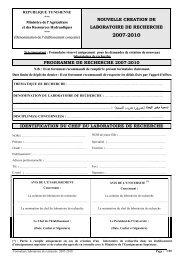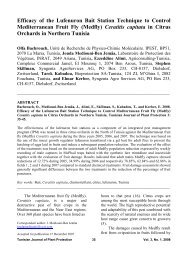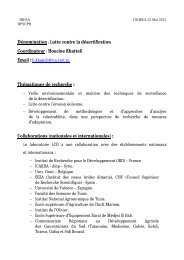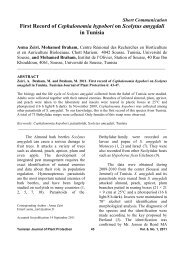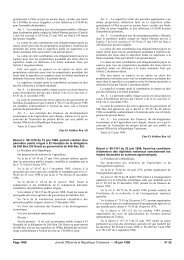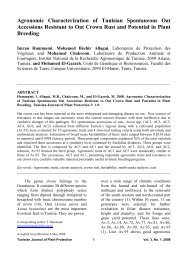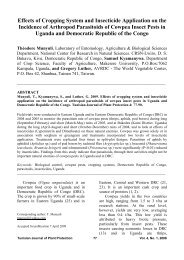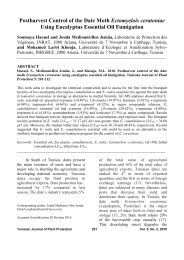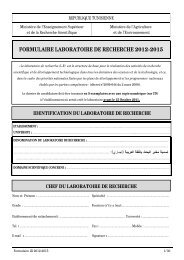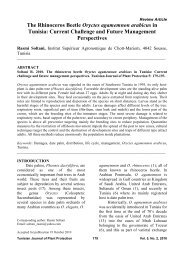Incorporation of Cestrum parquii (Solanaceae) Leaves in an ... - Iresa
Incorporation of Cestrum parquii (Solanaceae) Leaves in an ... - Iresa
Incorporation of Cestrum parquii (Solanaceae) Leaves in an ... - Iresa
Create successful ePaper yourself
Turn your PDF publications into a flip-book with our unique Google optimized e-Paper software.
<strong>Incorporation</strong> <strong>of</strong> <strong>Cestrum</strong> <strong>parquii</strong> (<strong>Sol<strong>an</strong>aceae</strong>) <strong>Leaves</strong> <strong>in</strong> <strong>an</strong><br />
Artificial Diet Affected Larval Longevity <strong>an</strong>d Gut Structure <strong>of</strong><br />
the Desert Locust Schistocerca gregaria<br />
Mohamed Ammar, Département de Protection des Pl<strong>an</strong>tes et Maladies Post-récolte,<br />
Institut National Agronomique de Tunisie, 1082 Cité Mahrajène, Tunisia, <strong>an</strong>d<br />
Sabr<strong>in</strong>e N’cir, Direction Générale de la Protection et du Contrôle de la Qualité des<br />
Produits Agricoles, M<strong>in</strong>istère de l’Agriculture et des Ressources Hydrauliques, 59<br />
Avenue Ala<strong>in</strong> Savary 1002 Tunis<br />
____________________________________________________________________________<br />
ABSTRACT<br />
Ammar, M. <strong>an</strong>d N’cir, S. 2008. <strong>Incorporation</strong> <strong>of</strong> <strong>Cestrum</strong> <strong>parquii</strong> (<strong>Sol<strong>an</strong>aceae</strong>) <strong>Leaves</strong> <strong>in</strong> <strong>an</strong><br />
Artificial Diet Affected Larval Longevity <strong>an</strong>d Gut Structure <strong>of</strong> the Desert Locust Schistocerca<br />
gregaria. Tunisi<strong>an</strong> Journal <strong>of</strong> Pl<strong>an</strong>t Protection 3: 27-34.<br />
In laboratory, desert locust Schistocerca gregaria was fed with <strong>Cestrum</strong> <strong>parquii</strong> (<strong>Sol<strong>an</strong>aceae</strong>) leaves<br />
which are appreciated by this <strong>in</strong>sect despite their toxic properties. Light microscopy observations revealed<br />
that the foregut structure <strong>of</strong> the 5 th stage is modified at cuticular <strong>in</strong>tima level where no exuvial space<br />
could be seen up to 7 days <strong>of</strong> treatment. By the 9 th day <strong>of</strong> treatment, this space started to appear but no<br />
new cuticle <strong>in</strong>timae were observed as <strong>in</strong> the case <strong>of</strong> the control. The height <strong>of</strong> the epithelial cells <strong>an</strong>d the<br />
thickness <strong>of</strong> muscular layers are reduced signific<strong>an</strong>tly. At midgut level, C. <strong>parquii</strong> elim<strong>in</strong>ated<br />
extracellular micro-org<strong>an</strong>isms by <strong>in</strong>toxication. The food digestion by epithelial cells was precociously<br />
achieved. On day 5, a proliferation <strong>of</strong> <strong>in</strong>tra-cellular microorg<strong>an</strong>isms was observed <strong>an</strong>d then decreased on<br />
day 7 to disappear on day 9 follow<strong>in</strong>g pl<strong>an</strong>t tox<strong>in</strong> accumulation. In the controls, proliferation <strong>of</strong> <strong>in</strong>tracellular<br />
microorg<strong>an</strong>isms was not observed before day 9.<br />
Key-words: <strong>Cestrum</strong> <strong>parquii</strong>, gut, microorg<strong>an</strong>isms, Schistocerca gregaria<br />
____________________________________________________________________________<br />
Plagues <strong>of</strong> desert locust, Schistocerca<br />
gregaria, have been recognized as a threat<br />
to agricultural production <strong>in</strong> North Africa<br />
(12). Because <strong>of</strong> the difficulty to predict<br />
locust outbreaks, the concerned countries<br />
used to apply pollut<strong>an</strong>t chemicals for<br />
locust control (9). As <strong>an</strong> alternative <strong>an</strong>d <strong>in</strong><br />
order to preserve the environment, these<br />
countries tend presently to apply<br />
preventive control methods based on the<br />
Correspond<strong>in</strong>g author: M. Ammar<br />
ammar.med@<strong>in</strong>at.agr<strong>in</strong>et.tn<br />
Accepted for publication 9 May 2008<br />
use <strong>of</strong> components considered as safe for<br />
the ecosystem (11).<br />
With<strong>in</strong> this control concept, some<br />
pl<strong>an</strong>t extracts <strong>in</strong>clud<strong>in</strong>g those <strong>of</strong> Olea<br />
europea <strong>in</strong> Tunisia (3), Eucalyptus<br />
gomphocephala <strong>in</strong> Algeria (8) <strong>an</strong>d<br />
Azadirachta <strong>in</strong>dica <strong>in</strong> Maurit<strong>an</strong>ia (4) were<br />
tested aga<strong>in</strong>st desert locust larvae. All<br />
these pl<strong>an</strong>t extracts revealed toxic effects<br />
on locust larvae <strong>an</strong>d were considered as<br />
effective <strong>in</strong> the control <strong>of</strong> S. gregaria.<br />
Some recent works <strong>in</strong>vestigat<strong>in</strong>g the<br />
effect <strong>of</strong> <strong>Cestrum</strong> <strong>parquii</strong> (<strong>Sol<strong>an</strong>aceae</strong>)<br />
leaves on <strong>in</strong>sects show the cytotoxical<br />
Tunisi<strong>an</strong> Journal <strong>of</strong> Pl<strong>an</strong>t Protection 27<br />
Vol. 3, No. 1, 2008
activity <strong>of</strong> this pl<strong>an</strong>t at foregut <strong>an</strong>d gastric<br />
caeca level (6, 1). This cytotoxical activity<br />
was confirmed by Kammoun et al. (10) by<br />
electronic microscope observation on<br />
hum<strong>an</strong> sperm.<br />
The aim <strong>of</strong> this work is to determ<strong>in</strong>e<br />
the effects <strong>of</strong> C. <strong>parquii</strong> leaf powder<br />
<strong>in</strong>corporated <strong>in</strong> <strong>an</strong> artificial diet on the<br />
longevity <strong>of</strong> the treated desert locust larvae<br />
<strong>an</strong>d their excrement dry weight <strong>an</strong>d to<br />
assess its effect on fore- <strong>an</strong>d mid-gut<br />
structures at the cytological level.<br />
MATERIALS AND METHODS<br />
Batches <strong>of</strong> 20 locust larvae <strong>in</strong> 5 th<br />
<strong>in</strong>stars from a desert locust mass rear<strong>in</strong>g<br />
conducted <strong>in</strong> laboratory were fed with a<br />
2% C. <strong>parquii</strong> leaf powder artificial diet<br />
(14). The control larvae were fed with a<br />
2% cabbage flour powder.<br />
Longevity (days)<br />
16<br />
14<br />
12<br />
10<br />
8<br />
6<br />
4<br />
2<br />
0<br />
Daily mortality <strong>an</strong>d excrement are<br />
recorded dur<strong>in</strong>g 9 days (life <strong>of</strong> the 5 th<br />
<strong>in</strong>stars larvae). Excrements are dried <strong>in</strong> 40°<br />
C dry<strong>in</strong>g oven dur<strong>in</strong>g 48 hours before<br />
weigh<strong>in</strong>g.<br />
Larvae are dissected on day 5, 7 <strong>an</strong>d 9<br />
to collect guts. Samples <strong>of</strong> guts were fixed<br />
<strong>in</strong> Bou<strong>in</strong> <strong>an</strong>d then embedded <strong>in</strong> paraff<strong>in</strong><br />
<strong>an</strong>d 7 µm layers were sta<strong>in</strong>ed <strong>in</strong> Patay (11)<br />
for light microscopy observations.<br />
RESULTS<br />
Effect on longevity. The effect <strong>of</strong> C.<br />
<strong>parquii</strong> on larval longevity was first<br />
observed on day 4 <strong>an</strong>d <strong>in</strong>creased on day 9<br />
(Fig. 1). At this stage, the control larvae<br />
moult whereas most <strong>of</strong> the treated larvae<br />
died follow<strong>in</strong>g moult<strong>in</strong>g difficulties.<br />
1 2 3 4 5 6 7 8 9<br />
Age (days)<br />
C. <strong>parquii</strong> leaves Control<br />
Fig. 1. Effect <strong>of</strong> C. <strong>parquii</strong> treatment on the longevity <strong>of</strong> S. gregaria larvae accord<strong>in</strong>g to the age.<br />
Tunisi<strong>an</strong> Journal <strong>of</strong> Pl<strong>an</strong>t Protection 28<br />
Vol. 3, No. 1, 2008
Effect on excrement weight. Fig. 2<br />
shows the lack <strong>of</strong> <strong>an</strong>ti-appetence toward<br />
fresh C. <strong>parquii</strong> leaves <strong>of</strong> locust larvae at<br />
the beg<strong>in</strong>n<strong>in</strong>g <strong>of</strong> food <strong>in</strong>take. At day 3, a<br />
toxic effect was observed with<strong>in</strong> the<br />
Me<strong>an</strong> excrement weight (g)<br />
0.16<br />
0.14<br />
0.12<br />
0.1<br />
0.08<br />
0.06<br />
0.04<br />
0.02<br />
0<br />
treated larvae result<strong>in</strong>g <strong>in</strong> larval mortality.<br />
This toxic effect becomes signific<strong>an</strong>t by<br />
day 6, which generally corresponds to the<br />
moult<strong>in</strong>g stage <strong>of</strong> the locust.<br />
1 2 3 4 5 6 7 8 9<br />
Age (days)<br />
C. <strong>parquii</strong> leaves Control<br />
Fig. 2. Effect <strong>of</strong> C. <strong>parquii</strong> treatment on <strong>in</strong>dividual excrement dry weight <strong>of</strong> S. gregaria larvae accord<strong>in</strong>g to the age.<br />
Effect on foregut structure. From<br />
plate 1 (A <strong>an</strong>d B), it appears that on the 5 th<br />
day, the epithelium is recovered by cuticle<br />
<strong>in</strong>timae for treated larvae as <strong>in</strong> the case <strong>of</strong><br />
the control. By the 7 th day, the cuticle<br />
<strong>in</strong>timae appears to be th<strong>in</strong>ner <strong>in</strong> the treated<br />
larvae (plate 1, C <strong>an</strong>d D). Plate 1 (F)<br />
revealed that exuvial space <strong>an</strong>d new<br />
cellular <strong>in</strong>timae were very conspicuous <strong>in</strong><br />
the control larvae. While <strong>in</strong>tact epithelial<br />
cells <strong>an</strong>d thick muscular layers were<br />
observed <strong>in</strong> the control with a clear<br />
separation between the new <strong>an</strong>d the old<br />
<strong>in</strong>timae, very disturbed th<strong>in</strong> <strong>an</strong>d non<br />
separated layers were seen <strong>in</strong> the treated<br />
larvae with import<strong>an</strong>t signs <strong>of</strong> cell damage<br />
(plate 1, E <strong>an</strong>d F).<br />
Effect on midgut structure. The<br />
development <strong>of</strong> <strong>in</strong>tra-cellular<br />
microorg<strong>an</strong>isms was observed earlier<br />
with<strong>in</strong> treated larvae (day 5) as compared<br />
to control larvae (day 9) (plate 2, A <strong>an</strong>d F).<br />
In fact, from plate 2 (B <strong>an</strong>d D) it is<br />
apparent that microorg<strong>an</strong>isms did not<br />
appear at days 5 <strong>an</strong>d 7, as <strong>in</strong> the untreated<br />
control. By contrast, numerous apparently<br />
health microorg<strong>an</strong>isms were detected <strong>in</strong><br />
the C. <strong>parquii</strong> fed larvae at day 5, but<br />
never at day 7 <strong>an</strong>d 9. The number <strong>of</strong> these<br />
microorg<strong>an</strong>isms was signific<strong>an</strong>tly reduced<br />
<strong>an</strong>d they revealed evident signs <strong>of</strong><br />
<strong>in</strong>toxication <strong>an</strong>d degeneration as <strong>in</strong>dicated<br />
by the presence <strong>of</strong> pycnotic nuclei (plate 2,<br />
C <strong>an</strong>d E).<br />
We notice that epithelium structure<br />
does not show yet difference between<br />
treated <strong>an</strong>t control <strong>in</strong>sects midgut, due<br />
probably to the fact that cellular<br />
development occurs after this digestion<br />
phase.<br />
Tunisi<strong>an</strong> Journal <strong>of</strong> Pl<strong>an</strong>t Protection 29<br />
Vol. 3, No. 1, 2008
Plate 1. Light microscope photographs <strong>of</strong> S. gregaria larval foregut structure after 5, 7, <strong>an</strong>d 9 days <strong>of</strong> C. <strong>parquii</strong><br />
leaves treatment<br />
Tunisi<strong>an</strong> Journal <strong>of</strong> Pl<strong>an</strong>t Protection 30<br />
Vol. 3, No. 1, 2008
Plate 2. Light microscope photographs <strong>of</strong> S. gregaria larval midgut structure after 5, 7, <strong>an</strong>d 9 days <strong>of</strong> C. <strong>parquii</strong><br />
leaves treatment.<br />
Tunisi<strong>an</strong> Journal <strong>of</strong> Pl<strong>an</strong>t Protection 31<br />
Vol. 3, No. 1, 2008
DISCUSSION<br />
In concord<strong>an</strong>ce with these<br />
observations, our previous results (2)<br />
showed that the rates <strong>of</strong> total <strong>an</strong>d soluble<br />
prote<strong>in</strong>s <strong>in</strong> the cuticle <strong>in</strong>creased at the end<br />
<strong>of</strong> the 5 th stage <strong>of</strong> desert locust larvae fed<br />
with C. <strong>parquii</strong> leaves <strong>an</strong>d accumulated<br />
<strong>in</strong> the cuticle follow<strong>in</strong>g protease<br />
<strong>in</strong>hibition effect. These <strong>in</strong>vestigations<br />
showed also that the cuticle was modified<br />
at the external <strong>in</strong>tegument level. The<br />
same authors concluded that <strong>in</strong> the lack <strong>of</strong><br />
exuvial liquid at apolysis, the reabsorb<strong>in</strong>g<br />
process is disturbed <strong>an</strong>d the exuviation<br />
does not occur.<br />
Previous studies <strong>in</strong>dicated that under<br />
normal conditions, the extracellular<br />
microorg<strong>an</strong>isms <strong>in</strong>hibit the digestion<br />
enzymes <strong>in</strong> the midgut (13). Once the<br />
nutrient needs <strong>of</strong> these microorg<strong>an</strong>isms<br />
are achieved, the <strong>in</strong>hibition is stopped <strong>an</strong>d<br />
degradation products are absorbed by gut<br />
cells. At this stage, <strong>in</strong>tra-cellular<br />
microorg<strong>an</strong>isms use these products <strong>in</strong><br />
order to achieve the digestion process<br />
(13).<br />
In the case <strong>of</strong> C. <strong>parquii</strong> treated<br />
larvae, therefore, extracellular<br />
microorg<strong>an</strong>isms seem to be destroyed by<br />
C. <strong>parquii</strong> sapon<strong>in</strong>s (3). The <strong>in</strong>hibition <strong>of</strong><br />
digestion enzymes is observed earlier <strong>an</strong>d<br />
on day 5 the <strong>in</strong>tra-cellular<br />
microorg<strong>an</strong>isms use the nutrients<br />
absorbed by <strong>in</strong>test<strong>in</strong>al cells for their<br />
further digestion. In the presence <strong>of</strong><br />
sapon<strong>in</strong>s, these <strong>in</strong>tra-cellular<br />
microorg<strong>an</strong>isms degenerate <strong>an</strong>d show<br />
pycnotic nuclei on day 7. Investigations<br />
about the identification <strong>of</strong> chemical<br />
structure <strong>of</strong> active subst<strong>an</strong>ces,<br />
demonstrate that these compounds are<br />
steroids sapon<strong>in</strong>s (steroid aglycone l<strong>in</strong>ked<br />
to oligosaccharide cha<strong>in</strong>) (5).<br />
ACKNOWLEDGMENTS<br />
This research was supported by funds ECproject<br />
« Development <strong>of</strong> a strategy for locust<br />
control, start<strong>in</strong>g from new developments <strong>in</strong> <strong>in</strong>sect<br />
endocr<strong>in</strong>ology ». We th<strong>an</strong>k Dr M. Chérif <strong>an</strong>d H.<br />
Ben Salah for the revision <strong>of</strong> the m<strong>an</strong>uscript.<br />
___________________________________________________________________________<br />
RESUME<br />
Ammar M. et N’cir S. 2008. <strong>Incorporation</strong> des feuilles de <strong>Cestrum</strong> <strong>parquii</strong> (<strong>Sol<strong>an</strong>aceae</strong>) d<strong>an</strong>s un<br />
milieu artificiel affecte la longévité et la structure du tube digestif du criquet pèler<strong>in</strong> Schistocerca<br />
gregaria. Tunisi<strong>an</strong> Journal <strong>of</strong> Pl<strong>an</strong>t Protection 3: 27-34.<br />
Au laboratoire, le criquet pèler<strong>in</strong> Schistocerca gregaria a été nourri par les feuilles de <strong>Cestrum</strong> <strong>parquii</strong><br />
(Sol<strong>an</strong>acées) qui sont appréciées par cet <strong>in</strong>secte malgré leurs propriétés toxiques. Au microscope<br />
photonique, la structure de l’<strong>in</strong>test<strong>in</strong> <strong>an</strong>térieur du 5 ème stade larvaire est modifiée au niveau de l’<strong>in</strong>tima<br />
cuticulaire qui montre l’absence de l’espace exuvial jusqu’au 7 ème jour du traitement. Au 9 ème jour, il<br />
commence à se former s<strong>an</strong>s que les nouvelles <strong>in</strong>tima cuticulaires n’apparaissent, par contre, elles sont<br />
déjà formées chez le témo<strong>in</strong>. Les cellules épithéliales dim<strong>in</strong>uent de la hauteur et les couches<br />
musculaires deviennent mo<strong>in</strong>s épaisses. Au niveau de l’<strong>in</strong>test<strong>in</strong> moyen, le C. <strong>parquii</strong> détruit les<br />
microorg<strong>an</strong>ismes extracellulaires par <strong>in</strong>toxication. La digestion du bol alimentaire par le tissu épithélial<br />
se fait précocement. Au 5 ème jour, nous observons une prolifération des microorg<strong>an</strong>ismes<br />
<strong>in</strong>tracellulaires qui dim<strong>in</strong>ue au 7 ème jour pour s’estomper au 9 ème jour suite à une accumulation des<br />
tox<strong>in</strong>es végétales. Chez le témo<strong>in</strong>, la prolifération des microorg<strong>an</strong>ismes <strong>in</strong>tracellulaires ne se m<strong>an</strong>ifeste<br />
qu’à l’âge de 9 jours.<br />
Mots clés : <strong>Cestrum</strong> <strong>parquii</strong>, <strong>in</strong>test<strong>in</strong>, microorg<strong>an</strong>ismes, Schistocerca gregaria<br />
___________________________________________________________________________<br />
Tunisi<strong>an</strong> Journal <strong>of</strong> Pl<strong>an</strong>t Protection 32<br />
Vol. 3, No. 1, 2008
___________________________________________________________________________<br />
ﺀﺍﺫﻐﻝﺍ<br />
ﻲﻓ<br />
( ﺕﺎﻴﻨﺎﺠﻨﺫﺎﺒ)<br />
<strong>Cestrum</strong> <strong>parquii</strong><br />
ﻲﻝﺎﺠﻝﺍ ﻙﺴﻤﻝﺍ ﻕﺍﺭﻭﺃ<br />
. 2008<br />
ﺹﺨﻠﻤ<br />
. ﺭﻴﺼﻨ ﻥﻴﺭﺒﺎﺼﻭ<br />
ﺩﻤﺤﻤ ،ﺭﺎﻤﻋ<br />
Tunisi<strong>an</strong> Journal <strong>of</strong> Pl<strong>an</strong>t Protection 33<br />
Vol. 3, No. 1, 2008<br />
لﺎﺨﺩﺇ<br />
. ﺎﻫﺩﻨﻋ ﻲﻌﻤﻝﺍ ﺔﻴﻨﺒﻭ Schistocerca gregaria ﻱﻭﺍﺭﺤﺼﻝﺍ ﺩﺍﺭﺠﻝﺍ<br />
ﺕﺎﻗﺭﻴ ﺭﻴﻤﻌﺘ ﻲﻓ ﺭﺜﺅﺘ<br />
ﻲﻋﺎﻨﻁﺼﻻﺍ<br />
Tunisi<strong>an</strong> Journal <strong>of</strong> Pl<strong>an</strong>t Protection 3: 27-34.<br />
<strong>Cestrum</strong> <strong>parquii</strong>ﻲﻝﺎﺠﻝﺍ<br />
ﻙﺴﻤﻝﺍ ﻕﺍﺭﻭﺄﺒ<br />
Schistocerca gregaria<br />
ﻱﻭﺍﺭﺤﺼﻝﺍ ﺩﺍﺭﺠﻝﺍ<br />
ﺔﻴﺫﻐﺘ<br />
،ﺭﺒﺨﻤﻝﺍ ﻲﻓ<br />
ﺔﻴﻨﺒ ﻲﻓ ﹰﺍﺭﻴﻐﺘ ﻲﺌﻭﻀﻝﺍ ﺭﻬﺠﻤﻝﺍ ﺕﺎﻅﺤﻼﻤ ﺕﺭﻬﻅﺃ . ﺔﻓﻭﺭﻌﻤﻝﺍ ﺔﻴﻤﺴﻝﺍ<br />
ﺎﻬﺼﺌﺎﺼﺨ ﻡﻏﺭ ﺓﺭﺸﺤﻝﺍ<br />
ﺎﻫﺫﺒﺤﺘ<br />
ﻲﺘﻝﺍ ( ﺕﺎﻴﻨﺎﺠﻨﺫﺎﺒ)<br />
ﻡﻭﻴﻝﺍ ﻰﺘﺤ ﻲﺨﻼﺴﻨﻻﺍ لﺌﺎﺴﻝﺍ ﺏﺎﻴﻏ ﻊﻤ ﺔﻤﻴﻤﺤﻝﺍ ﺓﺭﺸﺒﻝﺍ ﻯﻭﺘﺴﻤ ﺩﻨﻋ ﺱﻤﺎﺨﻝﺍ ﺭﻭﻁﻝﺍ ﻲﻓ ﺔﻗﺭﻴﻝﺍ ﺩﻨﻋ ﻲﻤﺎﻤﻷﺍ ﻲﻌﻤﻝﺍ<br />
،ﺩﻫﺎﺸﻝﺍ<br />
ﺩﻨﻋ ﺔﻅﺤﻼﻤﻝﺍ ﺔﻤﻴﻤﺤﻝﺍ ﺓﺭﺸﺒﻝﺍ<br />
ﺭﻭﻬﻅ ﻥﻭﺩﺒ<br />
ﻥﻜﻝﻭ لﺌﺎﺴﻝﺍ ﻥﻭﻜﺘ ﺃﺩﺒ ،ﻊﺴﺎﺘﻝﺍ ﻡﻭﻴﻝﺍ لﻭﻠﺤﺒﻭ<br />
. ﺔﻠﻤﺎﻌﻤﻝﺍ<br />
ﻥﻤ ﻊﺒﺎﺴﻝﺍ<br />
ﺕﺎﻨﺌﺎﻜﻝﺍ ﻲﻝﺎﺠﻝﺍ ﻙﺴﻤﻝﺍ لﺍﺯﺃ ،ﻁﺴﻭﻷﺍ<br />
ﻲﻌﻤﻝﺍ<br />
ﻯﻭﺘﺴﻤ ﻰﻠﻋﻭ<br />
. ﺔﻴﻠﻀﻌﻝﺍ ﺔﻘﺒﻁﻝﺍ ﺔﻜﺎﻤﺴﻭ<br />
ﺔﻴﺌﻼﻁﻝﺍ ﺎﻴﻼﺨﻝﺍ ﻭﻠﻋ ﺽﻔﺨﻨﺍ<br />
،ﺱﻤﺎﺨﻝﺍ ﻡﻭﻴﻝﺍ ﻲﻔﻓ<br />
. ﹰﺍﺭﻜﺒﻤ ﻲﺌﻼﻁﻝﺍ ﺞﻴﺴﻨﻝﺍ ﻑﺭﻁ ﻥﻤ ﻲﺌﺍﺫﻐﻝﺍ ﻊﻠﺒﻝﺍ ﻡﻀﻫ ﻊﻗﻭﻭ<br />
،ﻡﻤﺴﺘﻝﺍ<br />
ﺔﺠﻴﺘﻨ ﺎﻴﻼﺨﻝﺍ ﺝﺭﺎﺨ ﺔﻘﻴﻗﺩﻝﺍ<br />
ﻡﻜﺍﺭﺘ ﺭﺜﺇ<br />
ﻊﺴﺎﺘﻝﺍ ﻡﻭﻴﻝﺍ ﻲﻓ ﺕﻔﺘﺨﺍﻭ ﻊﺒﺎﺴﻝﺍ ﻡﻭﻴﻝﺍ ﻲﻓ ﺎﻫﺩﺍﺩﻋﺃ ﺽﺎﻔﺨﻨﺍ ﻡﺜ ﺎﻴﻼﺨﻝﺍ لﺨﺍﺩ ﺔﻘﻴﻗﺩﻝﺍ<br />
ﺕﺎﻨﺌﺎﻜﻝﺍ ﺭﺎﺸﺘﻨﺍ ﻅﺤﻭﻝ<br />
. ﻊﺴﺎﺘﻝﺍ ﻡﻭﻴﻝﺍ ﻲﻓ ﻻﺇ ﺩﻫﺎﺸﻝﺍ ﺩﻨﻋ ﺎﻴﻼﺨﻝﺍ لﺨﺍﺩ<br />
ﻡﺘ<br />
ﺎﻤﻜ<br />
ﺔﻘﻴﻗﺩﻝﺍ ﺕﺎﻨﺌﺎﻜﻝﺍ ﺭﺎﺸﺘﻨﺍ ﺔﻅﺤﻼﻤ ﻡﺘﺘ ﻡﻝ ﻥﻴﺤ ﻲﻓ ،ﺔﻴﺘﺎﺒﻨﻝﺍ ﻡﻭﻤﺴﻝﺍ<br />
Schistocerca gregaria <strong>Cestrum</strong> ، <strong>parquii</strong> ،ﺔﻘﻴﻗﺩ<br />
ﺕﺎﻨﺌﺎﻜ ،ﺀﺎﻌﻤﺃ : ﺔﻴﺤﺎﺘﻔﻤ ﺕﺎﻤﻠﻜ<br />
___________________________________________________________________________<br />
LITERATURE CITED<br />
1. Ammar, M. 2007. Caractérisation physiologique<br />
de la tr<strong>an</strong>sformation phasaire chez le criquet<br />
pèler<strong>in</strong>, Schistocerca gregaria Forsk.<br />
(Orthoptera, Acrididae), sa contribution à la<br />
connaiss<strong>an</strong>ce de la dynamique des essaims et<br />
<strong>in</strong>fluence de quelques compos<strong>an</strong>ts végétaux<br />
sur le développement. Doctorat d’Etat en<br />
sciences agronomiques, Institut National<br />
Agronomique de Tunisie, Tunisia, 230 pp.<br />
2. Ammar, M., Moumène, K., Ben Ammar, A.,<br />
Barbouche, N., <strong>an</strong>d Ben Hamouda, M.H. 2007.<br />
Difficulté de mue chez Schistocerca gregaria<br />
Forsk. (Orthoptera: Acrididae) nourri sur<br />
milieu artificiel à base de poudre de cestreau<br />
(<strong>Cestrum</strong> <strong>parquii</strong>, Sol<strong>an</strong>acée). Rev. INAT 21 :<br />
145-166<br />
3. Barbouche, N. 2001. La physiologie du<br />
développement et de la reproduction de<br />
Schistocerca gregaria Forsk. 1775<br />
(Orthoptera : Acrididae) et les modalités de<br />
leurs perturbations sous l’action de différents<br />
régimes alimentaires. Doctorat d’Etat en<br />
sciences agronomiques. Institut National<br />
Agronomique de Tunisie, Tunisia, 150 pp.<br />
4. Boughdad, A., K<strong>an</strong>e, C.M.H., <strong>an</strong>d Sy, A. 2005.<br />
Méthodes alternatives de contrôle du criquet<br />
pèler<strong>in</strong> d<strong>an</strong>s une aire de rémission en<br />
Maurit<strong>an</strong>ie. 9 p. In : AFPP-7 e Conf. Intern. sur<br />
les Ravageurs en Agriculture. Octobre 26 et<br />
27, Montpellier, Fr<strong>an</strong>ce.<br />
5. Chaieb, I., Boukamcha, H., Ben J<strong>an</strong>net, H., Ben<br />
Halima, M., Ben Hamouda, M. H., <strong>an</strong>d<br />
Mighri, Z. 2007. Purification <strong>of</strong> a natural<br />
<strong>in</strong>secticidal subst<strong>an</strong>ce from <strong>Cestrum</strong> <strong>parquii</strong><br />
(<strong>Sol<strong>an</strong>aceae</strong>). Pakist<strong>an</strong> J. <strong>of</strong> Biol. Sci. 10 :<br />
3822-3828.<br />
6. Chaieb, I., Trabelsi, M., Ben Halima-Kamel, M.,<br />
<strong>an</strong>d Ben Hamouda, M. H. 2007. Histological<br />
effects <strong>of</strong> <strong>Cestrum</strong> <strong>parquii</strong> sapon<strong>in</strong>s on<br />
Schistocerca gregaria <strong>an</strong>d Spodoptera<br />
litteralis. J. <strong>of</strong> Biol. Sci. 7: 95-101.<br />
7. Gabe, M. 1968. Techniques histologiques. Ed°<br />
Masson et C ie , Paris, Fr<strong>an</strong>ce, 1113 pp.<br />
8. Guendous-Benrima, A., 2005. Ecophysiologie et<br />
biogéographie du criquet pèler<strong>in</strong>, Schistocerca<br />
gregaria Forsk. 1775 (Orthoptera : Acrididae)<br />
d<strong>an</strong>s le Sud algérien. Doctorat d’Etat en<br />
sciences agronomiques, Institut National<br />
Agronomique d’El Harrach, Algeria, 210 pp.<br />
9. Gruys, P. 1993. Leçon à tirer du dernier fléau du<br />
criquet pèler<strong>in</strong> 1986-1988. Pages 19-30.<br />
Compte-rendu du sém<strong>in</strong>aire sur la lutte contre<br />
le criquet pèler<strong>in</strong> par les techniques exist<strong>an</strong>tes.
Evaluation des stratégies. Septembre 6-11,<br />
1993, De Wagen<strong>in</strong>gen, Pays-Bas.<br />
10. Kammoun, S., Saad, A., Aj<strong>in</strong>a, M., <strong>an</strong>d Trabelsi<br />
M. M. 2007. Spermicidal activity <strong>of</strong> extract<br />
from <strong>Cestrum</strong> <strong>parquii</strong>. Contraception 75 : 152-<br />
156.<br />
11. Lomer, C. J., Batem<strong>an</strong>, R. P., Johnson, D. L.,<br />
L<strong>an</strong>gewald, J., <strong>an</strong>d Thomas, M. 2001.<br />
Biological control <strong>of</strong> locusts <strong>an</strong>d grasshoppers.<br />
Ann. Rev. <strong>of</strong> Entomol. 46: 667-702.<br />
12. Showler, A. T. 1995. Desert locust control,<br />
public health, <strong>an</strong>d environmental susta<strong>in</strong>ability<br />
<strong>in</strong> North Africa. Pages 217-239. In : The North<br />
Afric<strong>an</strong> environment at risk. W. D.<br />
Swear<strong>in</strong>gen & A. Bencherifa, Ed.,West view<br />
Press, Boulder, CO., USA. 344 pp.<br />
13. Strebler, G. 1979. Incidence du jeune et de la<br />
présence de microorg<strong>an</strong>ismes d<strong>an</strong>s le tube<br />
digestif sur l’activité osidasique digestive de<br />
Schistocerca gregaria Forsk.. Acrida 8 : 35-<br />
46.<br />
14. Tira, R. 1975. Elevage du Criquet Pèler<strong>in</strong>,<br />
Schistocerca gregaria (Forskål 1775) sur<br />
milieu artificiel, son <strong>in</strong>térêt en entomologie<br />
appliquée. Thèse de docteur <strong>in</strong>génieur. Univ.<br />
Paris Sud, Orsay, Fr<strong>an</strong>ce, 45 pp.<br />
----- ----- ----- -------<br />
Tunisi<strong>an</strong> Journal <strong>of</strong> Pl<strong>an</strong>t Protection 34<br />
Vol. 3, No. 1, 2008




